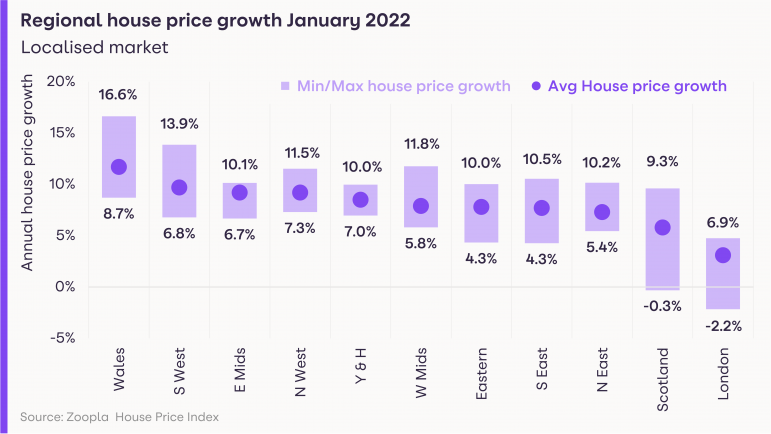
House price growth hit nearly 8% in January, according to the latest Zoopla House Price Index. The average value of a home in the UK rose by nearly 1%, or around £2,000, between October and January alone.
This pace of house price growth may seem counterintuitive given the growing economic headwinds – both the mortgage rate and cost of living rises that have been on the cards for some time, as well as rising global economic uncertainty caused by the tragic events in Ukraine.
However, the fundamentals underpinning this growth have been in place for some time, as buyer demand continues to outstrip the supply of homes being listed for sale.
We forecast last year that the high levels of buyer demand seen through late 2020 and 2021
were set to continue well into Q1 this year as the pandemic-led ‘reassessment of home’ continued – households reevaluating the space in which they live, as well as the location.
Add to this the changing landscape around COVID, with city centres once again opening up, reintroducing pent-up demand, and the stage was set for a lively start to the year
In fact, the first two months of the year were the busiest New Year period in at least five years for many across the market.
What is increasingly important to highlight however is the range of house price growth now being seen across the country. The average UK rate may be at 7.8%, but this ranges from price falls of -2.2% in the City of London to rises of 16.6% in Powys in Wales.
There are two main factors at play here. The first is the correlation between price rises and affordability. In a post-lockdown market, where a large cohort of office-working buyers have had the chance to move further afield, markets which offered more space at more affordable prices have seen the greatest competition for homes, and the highest price rises. An additional factor, in South Wales and the South West of England especially, is the added attraction of rural and coastal locations, which have added more pressure on demand in these markets.
The London market, with higher average prices and higher affordability ratios, is now starting to return to pre-pandemic conditions, with a step up in demand for flats, a market which has been relatively subdued compared to the vibrant market for terraced, semi-detached and detached houses during the last 18 months.
Yet the data on supply levels suggests the market is now at a turning point and that the supply squeeze is starting to ease. New listings are starting to run ahead of the five-year average level, suggesting that more homeowners are putting their home on the market. This could engender even more listings in time as one of the factors inhibiting listings at present is vendors’ worry that in such a fast-moving market, they will not be able to secure a purchase before their home is sold.
It will take some time to unwind the large imbalance between buyer demand and stock levels, but this is a sign that pipelines are starting to build, which will also lead to a return to more ‘normal’ market conditions, and an easing of the upwards pressure on pricing.
This, alongside the economic headwinds mentioned above will put the brakes on price growth during the course of 2022, although we still expect prices to rise, albeit at a more modest pace of between 2% and 4%.

